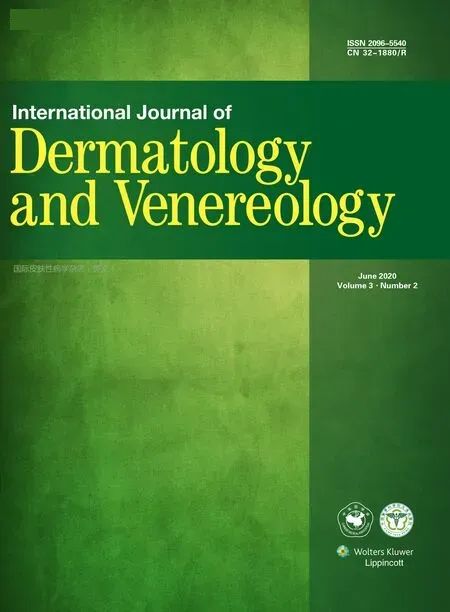Seborrheic Keratosis in a Young Woman:A Mimicker of Keratoacanthoma
Wen-Rui Li and and Lin Lin*
Department of Dermatology, Hospital for Skin Diseases (Institute of Dermatology), Chinese Academy of Medical Sciences and Peking Union Medical College, Nanjing, Jiangsu 210042, China.
Introduction
Seborrheic keratosis(SK)is a common benign lesion that is caused by slow maturation of keratinocytes and typically appears during the fifth decade of life.It usually presents as a yellowish circumscribed papule or plaque that may become exophytic, brown, or hyperpigmented.Cases of SK with keratoacanthoma (KA)-like lesions have been documented.1-3However,few reports in English literature have described this condition in young patients.We herein report the clinical and pathological findings of irritated SK with KA-like features in a young woman.
Case report
A 33-year-old woman in good general health presented with a facial lesion for two months.She reported no associated symptoms except that the lesion readily bled when scratched.She had no history of local trauma or sun exposure, and reported no personal or family history of skin cancer.
Physical examination revealed a 4×4mm sharply circumscribed dark brown, crateriform nodule with a keratotic core on the anterolateral right side of the nasolabial fold.The surface of lesion was rough near the apex and smooth at the base(Fig.1A).All other systemic examination findings were within normal limits.
After complete resection,examination of a skin biopsy demonstrated hyperkeratosis and acanthosis with proliferation of squamous and basaloid cells(Fig.1B).Horn cysts and squamous eddies were also found.Infiltration of a large quantity of lymphoid in the dermis was evident(Fig.1C).The patient's definitive diagnosis was irritated SK based on the clinical and pathological findings.
Discussion
SK is one of the most common benign epidermal tumors.It mostly arises in individuals older than 50 years and affects both sexes equally.Typically, it appears as sharply demarcated, slightly raised brownish patches or plaques in sun-exposed areas.Most cases of SK are easily identified clinically, but the tumor may mimic other lesions such as common warts, lentigines, actinic keratosis, Bowen's disease, KA, and more aggressive entities such as basal cell carcinoma, squamous cell carcinoma, and cutaneous melanoma.4KA is a distinctive skin tumor.The peak incidence is from 50 to 69 years of age,and the tumor exhibits male predominance.The lesion clinically presents as a rapidly enlarging papule, most frequently occurring on sun-exposed surfaces of the skin and evolving into a pink to fleshcolored, sharply circumscribed, dome-shaped nodule with a central keratin plug.It may then resolve slowly over months to leave an atrophic scar.5
Usually, SK and KA can be easily differentiated clinically.However,manifestation of SK as a crateriform lesion can be a pitfall in the differential diagnosis.2In such cases, biopsy is the gold standard diagnostic technique.Histopathologically, SK can be divided into six major variants: acanthotic, hyperkeratotic, adenoid,irritated, clonal, and melanoacanthoma.All variants are characterized by hyperkeratosis, acanthosis, and papillomatosis.In contrast, KA is characterized by symmetrical architecture with buttressing of adjacent nonsquamous epithelium on low-power magnification.Acanthotic squamous epithelial downgrowths can be found in early lesions, while a central crater filled by a keratin plug is present in more mature lesions.Acanthosis with proliferation of basaloid cells and/or hyperkeratosis with horn cysts and papillomatosis are useful clues to differentiate SK from KA.2On dermoscopy, irritated SK tends to lack the typical features of SK, such as multiple milia-like cysts, comedo-like openings, and fissures/ridges (brain-like appearance).It is characterized by small pinkish round structures on a whitish background.6In contrast,KA is characterized by white circles, keratin, and blood spots.However, KA shares some dermoscopic and clinical features with squamous cell carcinoma, and these two entities cannot be clearly identified by dermoscopy.5,7Thus, dermoscopy can be used to differentiate SK and KA,but biopsy is necessary for a diagnosis when the lesion mimics other conditions and especially when malignant proliferation should be excluded.8

Figure 1.Clinical and pathological findings of the patient.(A)Clinical appearance of the lesion.(B) The lesion was crateriform, showing hyperkeratosis and acanthosis with proliferation of squamous and basaloid cells (H&E, ×40).(C) Horn cysts, squamous eddies, and infiltration of a large quantity of lymphoid in the dermis are evident(H&E, ×100).
We have herein reported the rare case of irritated SK with KA-like features in a young woman.The presentation of the tumor as a crateriform lesion with a twomonth duration in a young woman was more likely to indicate KA.However, histological examination confirmed the diagnosis of irritated SK.Irritated SK with KA-like features is a rare lesion and even less commonly found in young women.Laimer et al.2retrospectively studied 1949 biopsies with histologic features of KA from 2000 to 2015 and found that 15 cases(0.8%)were reported as“verrucous SK with KA-like features”.Ogita et al.1histopathologically reexamined and reclassified a total of 380 epidermal crateriform tumors with a central keratin plug registered in the pathology files of the Sapporo Dermatopathology Institute from 2001 to 2013 and found that 12 cases(3.2%)were histopathologically diagnosed as SK.None of these patients were less than 45 years old.
Asymptomatic SK does not require removal except for cosmetic reasons.However, when the diagnosis is not clinically straightforward, complete excision of these lesions and a complete histological analysis is important to avoid overlooking a malignant diagnosis.
The aim of this report is to share our experience and draw attention to the differential diagnostic spectrum of KA-like features, especially in young individuals.Biopsy continues to be the gold standard diagnostic technique because this condition may mimic other dermatoses.
- 国际皮肤性病学杂志的其它文章
- Targetoid Hemosiderotic Nevus
- Eccrine Spiradenoma of the Forehead: A Case Report
- Lues Maligna in an Immune-Reconstituted Patient with Retroviral Infection: A Case Report
- A Case of Condyloma Acuminatum on the Nipple Detected via Dermoscopy
- Azathioprine Hypersensitivity Syndrome in an Asian Woman
- Linagliptin-Associated Bullous Pemphigoid: The First Case in China

